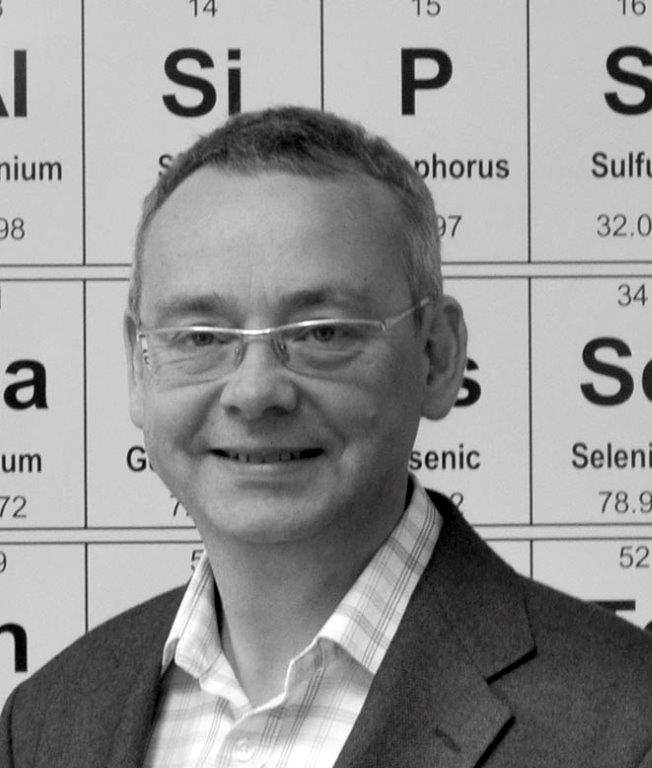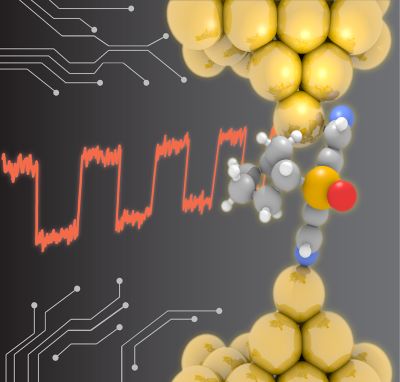
Professor Richard Nichols
Professor Chemistry
- +44 (0)151 794 3533
- Work email R.J.Nichols@liverpool.ac.uk
- Personal WebsiteNichols and Higgins Group
- About
- Research
- Publications
- Teaching
- Professional Activities
Research
Molecular electronics, electrochemistry, spectroscopy and single molecules.

Professor Richard Nichols is a chemist and has a research and teaching career of more than 25 years. His research work investigates aspects of conduction in single molecules, single molecule electrochemistry, molecular electronics, nanoscience, scanning probe microscopy, nanoscale electrochemistry, interfacial electrochemistry, metal plating and in-situ spectroscopic methods for studying electrode surfaces and batteries. He is an expert in the field of scanning probe microscopy, particularly as applied to in-situ electrochemical measurements and single molecule electronics. Professor Nichols is perhaps best known internationally for his pioneering in-situ electrochemical STM work. He was one of the first to carry out high-resolution studies of electrode processes, including the growth of metal electrodeposits. He has over 200 publications in peer-reviewed journals (h-index 59).
Prof. Nichols is one of the pioneers in research related to conduction in single molecules and biomolecules and since 2000 he has been developing techniques for the measurement of molecular electrical properties. Along with collaborators at The University of Liverpool he pioneered STM-based methods for the measurement of molecular conductance at the single molecule level, known as the I(s) and I(t) techniques (I: current; s: distance; t: time). He has demonstrated how current across a redox active molecular wire can be gated using electrochemistry and investigated the environmental, contact, length and temperature dependence of single molecule conductance. Recent work using these methods includes innovative electrochemical and photochemical switching of single-molecule conductance and probing the electrical properties of porphyrin wires and rings. He received the 2003 Tajima prize from the International Society of Electrochemistry and was elected a Fellow of the International Society of Electrochemistry in 2008. In 2016 I was awarded the Geoffrey Barker Medal of the Royal Society of Chemistry. Together with collaborators he has recently extended single molecule studies to both semiconducting contacts and also graphene contacts.
Research Group Membership
Research Grants
The Calcium-Air Battery
ENGINEERING & PHYSICAL SCIENCES RESEARCH COUNCIL
September 2017 - July 2019
Single-Molecule Plasmoelectronics
ENGINEERING & PHYSICAL SCIENCES RESEARCH COUNCIL
February 2016 - July 2019
Nanoparticle-based receptor dimerisation sensor.
BIOTECHNOLOGY & BIOLOGICAL SCIENCE RESEARCH COUNCIL
February 2003 - February 2006
Electrochemically Gated Single Molecule FETs
ENGINEERING & PHYSICAL SCIENCES RESEARCH COUNCIL
May 2013 - August 2016
Electronic Devices from Peptides (ELECTROPEP)
EUROPEAN COMMISSION
March 2006 - June 2008
Medium effects in single molecule electronics
ENGINEERING & PHYSICAL SCIENCES RESEARCH COUNCIL
December 2010 - November 2014
Single-molecule photo-spintronics
ENGINEERING & PHYSICAL SCIENCES RESEARCH COUNCIL
December 2014 - March 2018
Spectroscopic tools for improved protein secondary structure analysis in protein-heparan sulfate complexes
BIOTECHNOLOGY & BIOLOGICAL SCIENCE RESEARCH COUNCIL
July 2006 - October 2007
Ultrafast spectroscopy of molecular electronic junctions
LEVERHULME TRUST (UK)
November 2012 - November 2014
Scanning Tunnelling Spectroscopy of Nanoscale Structures.
ENGINEERING & PHYSICAL SCIENCES RESEARCH COUNCIL
June 2001 - October 2004
Porphyrin Single Molecule Wires for Nanoelectrics
ENGINEERING & PHYSICAL SCIENCES RESEARCH COUNCIL
November 2006 - February 2010
59th Annual Meeting of the International Society of Electrochemistry
ROYAL SOCIETY (CHARITABLE)
September 2008
Mechanisms of single molecule conductance.
ENGINEERING & PHYSICAL SCIENCES RESEARCH COUNCIL
August 2005 - July 2008
Production and characterisation of the properties of an "auroglycan" probe.
BIOTECHNOLOGY & BIOLOGICAL SCIENCE RESEARCH COUNCIL
May 2003 - May 2006
Nanoscale aspects of the surface electrochemistry of nickel.
ENGINEERING & PHYSICAL SCIENCES RESEARCH COUNCIL
December 1998 - August 2002
Extra mural research aimed at creating nanostructures exhibiting enhanced sensing activity towards CW agents.
DEFENCE SCIENCE & TECHNOLOGY LABORATORY (UK)
April 2003 - July 2005
Nanostructures for energy and chemicals production (NENA).
EUROPEAN COMMISSION
July 2004 - June 2007
The Role of Electrocatalysts in the Oxygen Reduction Reaction in Non-aqueous Electrolytes
ENGINEERING & PHYSICAL SCIENCES RESEARCH COUNCIL
March 2013 - September 2016
Single Molecular Conductance: The I(t) and I(s) Methods
ROYAL SOCIETY (CHARITABLE)
April 2006
In-situ Electrochemical Fabrication of Single Molecule Spintronic Junctions
ENGINEERING & PHYSICAL SCIENCES RESEARCH COUNCIL
March 2010 - December 2013
Supramolecular Nanorings for Exploring Quantum Interference
ENGINEERING & PHYSICAL SCIENCES RESEARCH COUNCIL
May 2015 - August 2018
Nanoscience of quasicrystals and related complex metallic alloys.
ENGINEERING & PHYSICAL SCIENCES RESEARCH COUNCIL
July 2006 - September 2009
Single molecule spintronics.
ENGINEERING & PHYSICAL SCIENCES RESEARCH COUNCIL
January 2006 - December 2008
University of Liverpool Institutional Discipline Bridging.
MEDICAL RESEARCH COUNCIL
October 2003 - October 2006
Combined Atomic Imaging and Diffraction Studies of the Electrooxidation of Supported Metal Monolayers
ENGINEERING & PHYSICAL SCIENCES RESEARCH COUNCIL
October 2009 - September 2013
Determination of the rate of ammonia production.
HEALTH AND SAFETY EXECUTIVE (UK)
June 2002 - February 2003